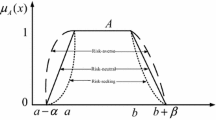Abstract
With increasing profit in securities investment, portfolio analysis has become a major topic for investors. We propose a fuzzy portfolio model as it is an efficient portfolio selection method associated with uncertain or vague returns. Although many researchers focus on studying the fuzzy portfolio model, they do not consider excess investment based on the selected guaranteed rates of return for some securities. To manage such an investment, a new fuzzy return function—where some securities are considered for excess investment based on the selected guaranteed rate of return—is introduced to improve the possibilistic mean and variance values, leading to a revised fuzzy portfolio model. Accordingly, to set certain securities for excess investment in the fuzzy return function, efficient portfolios for each selected guaranteed rate of return can be obtained under different levels of investment risk. Finally, we present a numerical example of a portfolio selection problem to illustrate the proposed model. This example shows that the expected rate of return of a lower guaranteed rate of return is larger than that of a higher guaranteed rate of return under different levels of investment risks. The portfolio analysis with some guaranteed rate of returns can provide more invested risk selection.

Similar content being viewed by others
References
Bazaraa, M.S., Jarvis, J.J., Sherali, H.D.: Linear programming and network flows, 2nd edn. Wiley, New York (1990)
Best, M.J., Grauer, R.R.: The efficient set mathematics when mean–variance problems are subject to general linear constrains. J. Econ. Bus. 42, 105–120 (1990)
Best, M.J., Hlouskova, J.: The efficient frontier for bounded assets. Math. Methods Oper. Res. 52, 195–212 (2000)
Chang, P.-T., Lee, E.S.: Ranking of fuzzy sets based on the concept of existence. Comput. Math. Appl. 27, 1–21 (1994)
Chen, I.F., Tsaur, R.C.: Fuzzy portfolio selection using a weighted function of possibilistic mean and variance in business cycles. Int. J. Fuzzy Syst. 18, 151–159 (2016)
Chen, S.-H.: Ranking fuzzy numbers with maximizing set and minimizing set. Fuzzy Sets Syst. 17, 113–129 (1985)
Deng, Y., Zhenfu, Z., Qi, L.: Ranking fuzzy numbers with an area method using radius of gyration. Comput. Math. Appl. 51, 1127–1136 (2006)
Guo, S., Yu, L., Li, X., Kar, S.: Fuzzy multi-period portfolio selection with different investment horizons. Eur. J. Oper. Res. 254, 1026–1035 (2016)
Gupta, P., Mehlawat, M.K., Yadav, S., Kumar, A.: A polynomial goal programming approach for intuitionistic fuzzy portfolio optimization using entropy and higher moments. Appl. Soft Comput. 85, 105781 (2019)
Huang, X.-X.: Mean-semivariance models for fuzzy portfolio selection. J. Comput. Appl. Math. 217, 1–8 (2008)
Jain, R.: Decision making in the presence of fuzzy variables. IEEE Trans. Syst. Man Cybern. 6(698–703), 1976 (1985)
Li, X., Qin, Z.-F., Kar, S.: Mean-variance-skewness model for portfolio selection with fuzzy returns. Eur. J. Oper. Res. 202, 239–247 (2010)
Liagkouras, K., Metaxiotis, K.: Multi-period mean–variance fuzzy portfolio optimization model with transaction costs. Eng. Appl. Artif. Intell. 67, 260–269 (2018)
Mansour, N., Cherif, M.S., Abdelfattah, W.: Multi-objective imprecise programming for financial portfolio selection with fuzzy returns. Expert Syst. Appl. 138, 112810 (2019)
Markowitz, H.: Portfolio selection. Journal of Finance 7, 77–91 (1952)
Merton, R.C.: An analytic derivation of the efficient frontier. J. Finance Quant. Anal. 10, 1851–1872 (1972)
Pang, J.S.: A new efficient algorithm for a class of portfolio selection problems. Oper. Res. Int. Journal 28, 754–767 (1980)
Perold, A.F.: Large-scale portfolio optimization. Manage. Sci. 30, 1143–1160 (1984)
Rao, P.P.B., Shankar, N.R.: Ranking fuzzy numbers with a distance method using circumcenter of centroids and an index of modality. Adv. Fuzzy Syst. 2011, 178308 (2011). https://doi.org/10.1155/2011/178308
Saade, J.J., Schwarzlander, H.: Ordering fuzzy sets over the real line: an approach based on decision making under uncertainty. Fuzzy Sets Syst. 50, 237–246 (1992)
Sharpe, W.F.: Portfolio theory and capital markets. McGraw-Hill, New York (1970)
Tanaka, H., Guo, P., Türksen, I.B.: Portfolio selection based on fuzzy probabilities and possibility distributions. Fuzzy Set and Systems 111, 387–397 (2000)
Tsaur, R.C.: Fuzzy portfolio model with different investor risk attitudes. Eur. J. Oper. Res. 227, 385–390 (2013)
Tsaur, R.C.: Fuzzy portfolio model with fuzzy-input return rates and fuzzy-output proportions. Int. J. Syst. Sci. 46, 438–450 (2015)
Vörös, J.: Portfolio analysis—an analytic derivation of the efficient portfolio frontier. Eur. J. Oper. Res. 203, 294–300 (1986)
Wang, Z.-X., Mo, Y.-N.: Ranking fuzzy numbers based on ideal solution. Fuzzy Inform. Eng. 2, 27–36 (2010)
Zhang, W.G.: Possibilistic mean–standard deviation models to portfolio selection for bounded assets. Appl. Math. Comput. 189, 1614–1623 (2007)
Zhang, W.G., Nie, Z.K.: On possibilistic variance of fuzzy numbers. Lecture Notes Artif. Intell. 2639, 398–402 (2003)
Zhang, W., Nie, Z.: On admissible efficient portfolio selection problem. Appl. Math. Comput. 159, 357–371 (2004)
Zhou, W., Xu, Z.: Portfolio selection and risk investment under the hesitant fuzzy environment. Knowl.-Based Syst. 144, 21–31 (2018)
Zhou, X., Wang, J., Yang, X., Lev, B., Tu, Y., Wang, S.: Portfolio selection under different attitudes in fuzzy environment. Inf. Sci. 462, 278–289 (2018)
Author information
Authors and Affiliations
Corresponding author
Rights and permissions
About this article
Cite this article
Tsaur, RC., Chiu, CL. & Huang, YY. Guaranteed Rate of Return for Excess Investment in a Fuzzy Portfolio Analysis. Int. J. Fuzzy Syst. 23, 94–106 (2021). https://doi.org/10.1007/s40815-020-00990-y
Received:
Revised:
Accepted:
Published:
Issue Date:
DOI: https://doi.org/10.1007/s40815-020-00990-y




